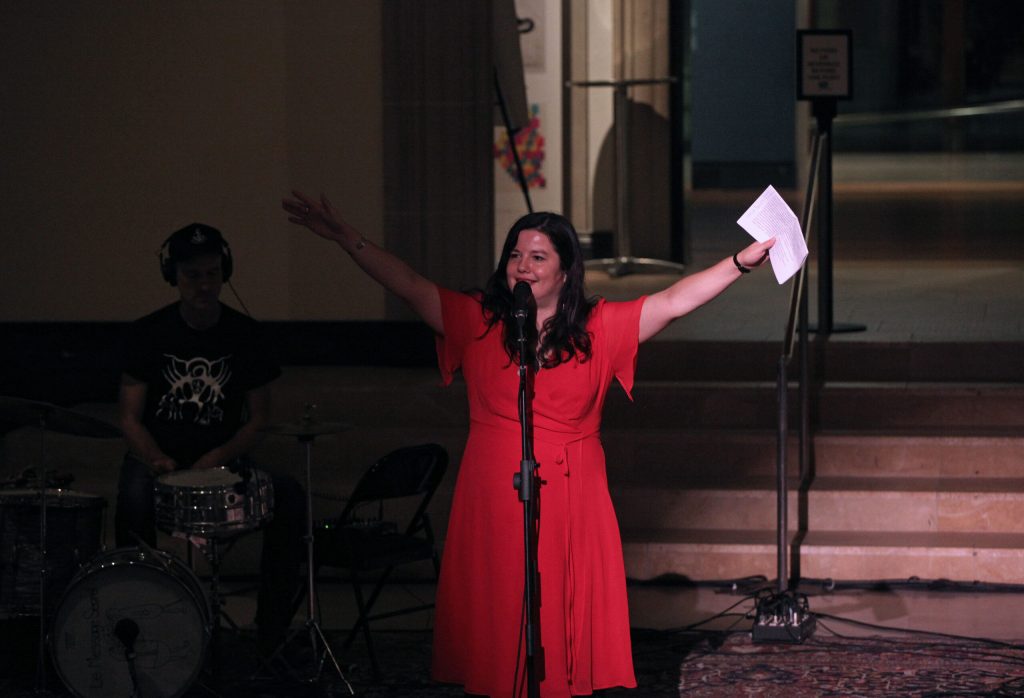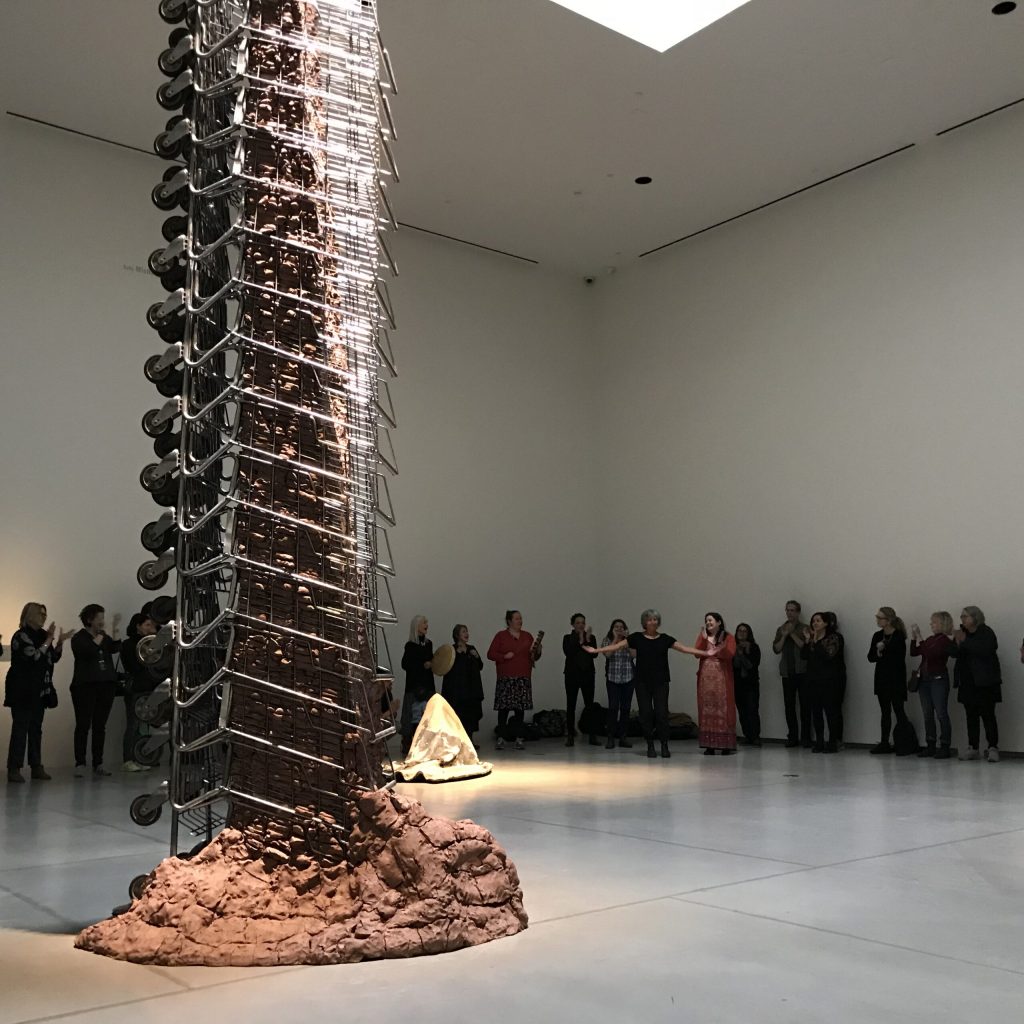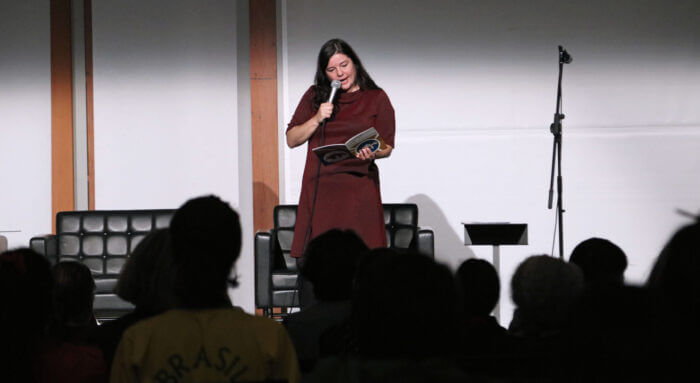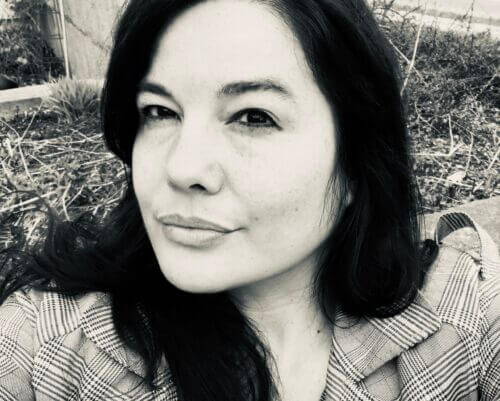First Nations Curator Wanda Nanibush

Wanda Nanibush is a Toronto-based Anishinaabe curator, artist, activist and educator. Her work focuses on First Nations culture, and she is the first Curator of Indigenous Art at the Art Gallery of Ontario. The powerful and unique art of Indigenous cultures has been brought to the forefront of the North American art world with the help of her work. Her love for art and an artist’s work is transparent as she gives art its own freedom of space, elevating artists into the larger conversations around art and allowing the artist’s desire and dreams to shine through their work.
FRONTRUNNER caught up with Nanibush for an in-depth discussion around storytelling through art, her cultural identity and the importance of human connections as a basis for life, her book, Violence No More: The Rise of Indigenous Women, among countless other topics. Her scholarship and humour are enlightening and created an open dialogue around Indigenous lives, the earth and the importance of bringing art into every conversation.
How were you first drawn to the art world?
I was drawn to art when I was young…visual arts as a form of discourse or communication. So, very much tied into thinking about who we are as Indigenous people, as Anishinaabe. Art was a place where I felt like you could go and have a more open-ended conversations about what that means for the future. The first artist I was ever really drawn to was Arthur Schilling, a painter from outside of Toronto. He made these beautiful paintings in a kind of expressionist style of people he saw on his reserve. They were beautiful, like children and mothers and fathers, and I just thought that that was the most beautiful thing I’d ever seen. We don’t see ourselves in art very much as reserve people. So, he really was somebody. He’s also related to me through family. So yeah, I would say that’s the first artist that sort of drew me into that. When I was 16, I went to Ottawa in ’92 to see the Land, Spirit, Power exhibition at The National Gallery of Canada, and then Indigena, which was a Canadian Museum of Civilization. They had the first big national exhibition of contemporary Indigenous art. Back then, we would have probably called it native art. Yeah, it just blew my mind. I didn’t even know people made this kind of stuff. You know, we grew up with drawing and painting, but we don’t see installation art and all this multimedia stuff. There’s no real education in, either.
My background is in dance and theater, so personally that’s where I come from. But visual arts, this was something else. Just the amount of work…and also the sense that our world was way more complex. We were given an opportunity to express and art became this way of showing us kind of a different future. Yeah, so I’d say that’s how I got started as a younger person. It’s funny now because I know a lot of the artists who were in those shows and I am friends with them. And, you know, I’m friends with Robert who curated the one exhibition. It’s like, it’s kind of amazing now to see… like, me as this kid… who didn’t have much art education or much exposure. Then seeing myself now, you know? Hanging out with these people and hearing how they thought, it’s kind of amazing. It’s funny how life works out that way.

Installation view
Art Gallery of Ontario, 2017
Works shown (floor): Tim Whiten, Metamorphosis (1978-89); Rebecca Belmore, Rising to the Occasion (1987-1991);
Will Goritz, Genre series (1984); The Clichettes, Up Against The Wallpaper (1988-89)
Curated by Wanda Nanibush
Photo credit: Dean Tomlinson
Copyright, Art Gallery of Ontario
When did you realise that you wanted to pursue a career/life as a curator, educator and artist, speaking to conversations around Indigenous lives and the earth?
I don’t think I ever think in terms of career. So, I’ve never thought of myself as having a career or wanting a career. I literally just follow whatever’s in front of me. So, that’s why you look at my resume and it doesn’t look like anyone else’s. I didn’t follow a career path. One of my first major jobs was working for the Children’s Aid Society as a youth-in-care coordinator, and I was a teenager myself. I just remember seeking out artistic projects and artistic things…engaging for healing and understanding, and all that kind of stuff. So, I actually came at it through that route. Just thinking about the impact of art on trauma is really where I was coming at it from. I kept thinking that art actually has its own voice and has its own way of addressing that. It’s very different than what a social worker might do, or what a psychologist might do. I found that it was more helpful in lots of ways, especially for teenage youth-in-care. And even for myself, for that matter. So, many of my jobs after that were all linked into festivals. I was always a very good organizer. I actually started in film and video festivals, curating those. I kind of fell into curating in this strange way because I loved people’s work and I wanted other people to see it. It was a very simple kind of beginning in that way.
Sure, I don’t come from an Art History background and all that. I did eventually do a master’s in curatorial studies; mostly to get some of the modern art history and contemporary history that’s Western because that’s not my background. Yeah, just to get a sense of how people are writing about it. How does Indigenous art fit into that? I’ve always worked with, I would say, a larger field of art that isn’t white. I’ve done a lot of work with Middle Eastern…but my interests are quite broad and global. Still, I could tell that, you know, for some reason this art wasn’t making its way into the museums and the history books. So, I wanted to see what those connections might be. That’s why I went back to school. I think sometimes people when they think of career…they just think of the resume and the paper and everything needs to go “A,B,C.” So yeah, just as a side note. For me, it is usually just really human connections is where I start from.

I think that’s such a great point – starting from human connections. How do you choose what Indigenous artists and exhibits to showcase at the AGO? What is that process like?
Well, I was brought into the AGO to really look and examine how they’re presenting Indigenous art. So, I got a good grasp on the language they use in labels, the work that they’re presenting, that kind of thing. So, when I came in…I came in at a certain level (assistant curator), because that’s all we could do at that time. But the idea was always to push for an actual curator of Indigenous art position at the AGO. I really felt like we needed a structure to say that Indigenous art is important, first of all, because there wasn’t enough of one. And so, one of my goals was that and the re-naming of the department, thinking about an Indigenous structure for power. Thinking about using the treaty relationship: all these ways that we can bring Indigenous thought and ways of being into the museum. So that’s one thing.
I think the other thing is that I had to think about what is the job good for, you know, as far as what it can bring to the Indigenous arts community. I do start with living, contemporary artists. That is my starting point. Not from some art historical narrative. It’s not from anything else. I really wanted to see what is good for contemporary Indigenous arts. I think one thing the AGO can do really well is these large solo exhibitions. They can begin to set history and begin to kind of elevate artists into the larger conversation around art. Which is where artists want to be, you know, they don’t want to be siloed. They want to be out there with everyone else, too. It’s kind of an educational opportunity, you know, to open a lot of people’s minds to something they’ve never seen, never witnessed never experienced that might shift the culture in a way. So, definitely choosing art that kind of does that as well.
My background working in the independent art scene in Toronto for so long meant that I knew a lot of artists that had never been engaged by the AGO in the ’70s and ’80s. And it meant that we could bring forward like this political conversation right to the front, like, what did artists actually desire? What was their dream for the arts at that time? Where are we now? How far did we come? Did we slide backwards? Did we go forward? You know, all that kind of thinking…because it was a very revolutionary time. It allowed me to examine the collection and see where the holes are and think about building a program around exhibitions and acquisitions to fill those gaps. We’ve done a series of work with black Canadian photographers, for example, trying to build that history, build those connections, and build that collection.

Tower (2018)
Round Dance at her exhibition, Rebecca Belmore: Last Chance
Art Gallery of Ontario
Curated by Wanda Nanibush
Photo credit: Shani Parsons
You already touched upon how art has a voice and is a powerful resource for learning. Can you tell me a little bit more about the significance of art and how it can help educate people about Indigenous land rights, the history of Canada, and other Indigenous experiences?
I feel a million things at once. I mean, it’s a complicated thing because I don’t actually use art. So, that’s the first thing. I believe that the artists themselves are bringing politics into their work, and it’s my job to kind of pull it out, or show it in the way that it’s speaking for itself. It’s really important to me to give art its own freedom of space…in place and narrative. My sense of what education is, is a little bit different, I think. So, there are works that will tell people, you know, the history of residential schools and the Indian act and all that, as artists are taking up these subjects.
What is the artist interested in? A work like “Time Dissolve” by Carl Beam deals with residential school history. But it’s not telling you, “This is what the residential school history is,” you know. In fact, he’s focused on resistance. It’s very clear what he’s saying, you know, addressing this history through art. He circles, like his friends, and you can see that friendship became a way that the students resisted the pain of the schools. I really take the artist’s lead on where they’re leading us…in terms of what is the history? What is the politics and what is the education that they want to arrive at (so that we aren’t doing these didactic exhibitions)? I would also say I don’t have a lot of labels about the pain of colonialism all over my shows. There are hints and moments and things that you might need to know to understand a work. But that’s as far as it goes. I’m really, really interested in showing a totally different side, not the victim. I’m really not interested in victim narratives. So, that’s really important. And I’m not interested in shaming, either or creating white guilt, you know, so it’s like these things that we have to dance through when we want to share these stories. You have to make sure that the person who’s sharing that story is protected in that process.
I think there was somebody who said it, and I don’t remember who, but we all repeat it and we don’t remember who said it first: to be born First Nations is to be born political. So, there is kind of this base level at which I think all work is political. You know, even abstract painting from New York in the ’70s is political. Everything has its politics inside of it. You just have to pull it out. This idea that art could ever not be political I think is a farce.
What are some of the Anishinaabe values and experiences that are manifested in the type of art that you create?
Well, I think as an Anishinaabe person, some of our value systems are embedded in a kind of humility. It’s the idea that you protect the independent spirit, so I think that definitely comes into play. The work that I make, because I’m really interested in the complexity of the relationship between narrative and image, and how when you separate them out from each other, and then put them back together and in different ways. The images and meanings can always shift depending on what narrative is put with it. Also, narrative itself shifts based on what images it’s placed with. So, I did this piece called “Passive Resistance”, which was really thinking about how the Haudenosaunee always make fun of the Anishinaabe as being passive. It’s just a joke. It’s not serious. It’s jokes we throw around at each other, but that we were passive because we’re not always raising the cause in terms of nationhood. In the same way, like we’re much quieter sort of political activists, and much quieter on the sovereignty front in some ways, or the way we talk about it. Actually, I do borrow considerable amount of thinking from Haudenosaunee thinkers and writers because they are so amazingly strong at thinking about governance and sovereignty.

About your book, Violence No More: The Rise of Indigenous Women. Can you speak a bit more about this issue to give readers an understanding of what is happening in Canada in relation to Indigenous women and what it’s like to write this book?
So that book hasn’t been published yet! I know they’ve been selling it like for so long and I’m just like, “Oh my god, so much pressure.” It’s all pre-order. Oh, yeah, I’m actually under a major gun because it’s so late. It’s so late because I feel this shifting constantly. So, every time I look at the murdered and missing Indigenous women report, I have to start that chapter all over again. It’s constantly shifting.
The original impetus for the book was the discussion around inquiries and what they do. We’ve had so many inquiries, right. The Royal Commission on Aboriginal peoples, for example, is still one of the best documents that we’ve never implemented as a country. Every time we do something more, there is this like fatigue in our community around, “But what will it produce?” and “Will you actually act on it?” So, my emphasis around that was to look at all those reports that we’ve written. Indigenous women have already said what needs to be done. Really what we need is action on these things. So, I thought, how could I take these reports which no one wants to read, except, like me? Or maybe you. You know? Take them and turn them back into the human side of it again. So, thinking about how can we talk about these solutions and really discuss where they come from and how they come from largely women writers. Largely women are working in the fields of health, education, all the fields that kind of deal with our children and the health of our communities. So, it’s about taking what they know and putting it out there in a form that people can understand and read and want to read.
But then there’s a line too, because my own life has been really marred by violence in my childhood. I think a lot of Indigenous people have this experience, and the different kinds of violence are actually deeply connected. So, you can’t parcel out violence against Indigenous women without also thinking about the larger colonial context of violence and different kinds of violence that happens within our communities, and between Indigenous and non-Indigenous people. So, it was also about going through that and trying to understand the colonial roots of violence and what’s happening today, while at the same time talking about solutions to it. That’s sort of where that’s coming from. I’m a deeply private person. It has been really hard to kind of imagine sharing these very personal experiences with people. But also, for me, it’s a matter of trust. Like, why would you read something from me if you don’t understand where I’m coming from at it, and what my experiences are and how I process them? So, I think it’s really important to have that in there.
You also brought up the topic of providing solutions to the problems. Can you tell us a bit more about that?
Well, I just finished the chapter on the police and the RCMP, which starts in the 1700s to now. So, I’m trying to compress time so people can understand the connections between the past and the present. But, there are some really clear, clear solutions that people have talked about. Some of it has been implemented. You can, you know, look at the Ontario policing. There are some implementations that have happened there that are really successful. There’s also the idea that we need to investigate the police as well, because they’ve been perpetrators of violence. That is something that we haven’t been able to get done, especially in Northern BC. There are so many cases where police have been the perpetrators of violence against Indigenous people and women and we have no recourse for prosecuting or investigating or that kind of thing.

What’s your next project or something you’re working on that you can tell us about? Of course, the book as an obvious one, not to point fingers!
[Laughs] Yeah, there is just so much going on. I am working on another solo exhibition of an artist at the Art Gallery of Ontario. I can’t say what it is yet, because it’s not public. We are just finishing the tour of Rebecca Belmore’s Facing the Monumental in Colorado. There are some cross-border exhibitions between us and New Zealand and Australia; some projects there that are going to come down the pipe. We’re doing a catalogue for the McLean Center, that should come out in October. That will give a bit of the history of how we’ve arrived where we are. I’m also writing a little mini-history of Indigenous art at the AGO right now, which has been really fascinating to go through all the people. Oh god, there are so many things [laughs], there are a lot of things. We’re working on a film about Indigenous Resistance that’s now at the editors called A Love Letter To My People. I’ve had a little bit of a weird time getting projects done. AABAAKWAD will happen again in 2021, which is a gathering of International Indigenous artists, and curators, which just took place in Sydney, Australia. Lots and lots coming.
I just don’t sleep much, I guess! [Laughs] Five! I sleep five hours [laughs]. I was an insomniac when I was a kid, so five hours is awesome.
Last question: what Indigenous artists, musicians or filmmakers would you like to see FRONTRUNNER interview next?
Darlene Naponse, Cris Derksen, Michael Belmore, Ursula Johnson, Marianne Nicolson…there are so many! But I think those would all be interesting folk.